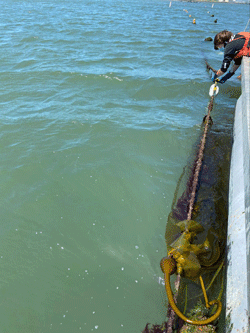
Researchers will add 0.33 acres to its existing seaweed farm and create a kelp hatchery onshore at the Humboldt State Marine Lab. The farm, called HSU-ProvidenSea, sits in a permitted area just a few hundred yards off the shores of Humboldt Bay. Students will gain practical ocean farming experience, monitor the reproduction and growth of the bull kelp, track factors like water quality and temperature, and evaluate the cost of seeding and production.
After launching California’s first open-water commercial seaweed farm last year, researchers noticed that bull kelp was growing naturally on lines intended for dulse seaweed. “I was skeptical about growing bull kelp in Humboldt Bay given bull kelp’s usual natural habitat on the open coast, but then we started noticing some natural recruits of young bull kelp growing on our long line,” says Rick Zechman, Co-Principal Investigator on the project and Associate Dean and Director of Marine Sciences in the College of Natural Resources & Sciences. The discovery opened up a huge potential for growing bull kelp in Humboldt Bay, explains Zechman.
“Bull kelp was an obvious choice not only because it was growing naturally in the Bay, but also because of the unprecedented decline of California’s kelp forests,” says project leader Rafael Cuevas Uribe, HSU Professor of Fisheries Biology.
Kelp traps an outsized amount of carbon dioxide and reduces acidification, a byproduct of a rapidly changing atmosphere. Kelp can also be used for human consumption, animal feed, agricultural fertilizer, as sustainable alternatives to single-use plastic, and more.
A key component of the kelp farm is the bull kelp hatchery at the HSU Marine Lab where bull kelp spores are collected and encouraged to settle onto strings wrapped on spools and grown in recirculating seawater. Once juvenile kelp reach a certain size, the string can be transferred onto the underwater lines of the farm. This innovative multi-line 3D farm was developed by Clifford A. Goudey and Associates), a professional engineering services company that develops farm systems and mechanization specifically for the seaweed industry.

This aquaculture expansion is funded through CSU’s Agricultural Research Institute and matched by a USDA Hispanic-Serving Institution grant called Echale Ganas. The kelp hatchery at HSU’s Marine Lab will supply seeded rope for aquaculture needs.
“Karen Gray, who supported us to launch HSU-ProvidenSea, helped us acquire the farm lease and required permits. Thanks to her we now have the approval to grow bull kelp,” says Zechman. Gray is the California Reef Manager for GreenWave, a nonprofit organization based on the East Coast with a mission to provide training for new ocean farmers.
“We have been talking with several companies who are enthusiastic about using the bull kelp harvested on the HSU ProvidenSea Farm,” says Cuevas Uribe. “This kind of collaboration between the aquaculture industry, academia and a public agency like the Humboldt Bay Harbor District is a win/win.”
Note: This story was originally published on July 12, 2021.